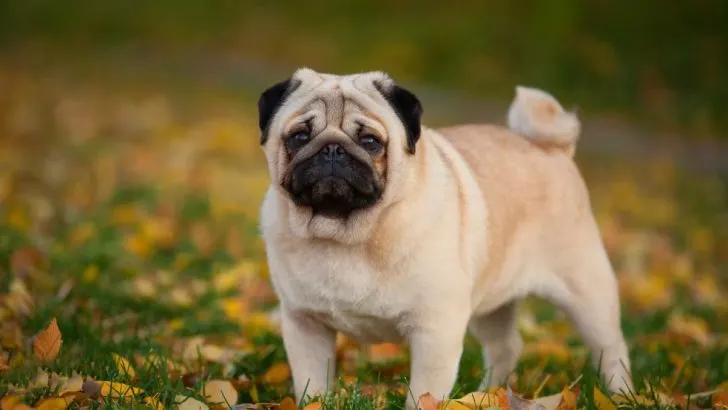Welcome aboard, fellow dog lovers! Today, I want to help you discover some secrets about Pug growth charts and why they matter – and give you some extra tips. Sounds fun? Well then, let’s get started!
Known for their small bodies, flat faces, and loud snoring, Pugs are some of the most adorable pups out there. They are cute and fun – what’s not to love?
While this might seem insignificant, knowing just how big Pugs can grow can be of crucial importance when caring for your pet. A dog’s size can tell you a lot of things about his general health, as well as give you some care insights.
Without further ado, here is a comprehensive guide to Pug growth charts with some additional information!
Pug Growth Chart
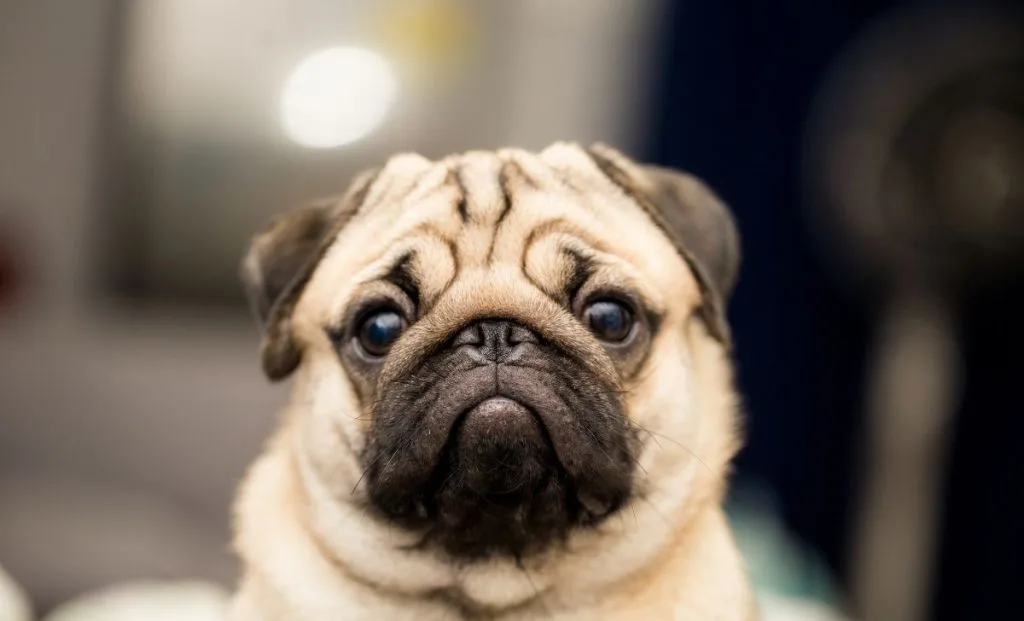
According to the American Kennel Club (AKC), the healthy adult size for Pugs is between 10 and 13 inches, and most Pugs will be according to the breed standard in this regard.
The precise height of a Pug depends on the dog’s gender, as males are known for being a bit taller than females.
| Age | Male | Female |
| 0 Months | 2 – 3 ins | 2 – 3 ins |
| 1 Month | 3 – 4 ins | 3 – 4 ins |
| 2 Months | 4 – 5 ins | 4 – 5 ins |
| 3 Months | 5 – 6 ins | 5 – 6 ins |
| 4 Months | 6 – 7 ins | 6 – 7 ins |
| 5 Months | 7 – 8 ins | 7 – 8 ins |
| 6 Months | 8 – 9 ins | 8 – 8.5 ins |
| 7 Months | 9 – 10 ins | 9 – 9.5 ins |
| 8 Months | 9 – 11 ins | 9 – 10 ins |
| 9 Months | 10 – 11 ins | 9.5 – 10.5 ins |
| 10 Months | 10 – 11.5 ins | 9.5 – 10.5 ins |
| 11 Months | 11 – 12 ins | 10 – 11 ins |
| 12 Months | 11 – 12.5 ins | 10 – 11.5 ins |
| 2 years | 11 – 13 ins | 10 – 12 ins |
Pug Weight Chart
While small-bodied, Pugs are still sturdy dogs with a fairly significant weight.
The desired healthy weight is between 14 and 18 pounds, but most adult Pugs have a few pounds more, as you can see from the chart below:
| Age | Male | Female |
| 0 Months | 1 – 2 lb | 1 – 2 lbs |
| 1 Month | 2 – 4 lbs | 2 – 3.5 lbs |
| 2 Months | 4 – 6 lbs | 3 – 5 lbs |
| 3 Months | 5 – 8 lbs | 4 – 7 lbs |
| 4 Months | 7 – 10 lbs | 6 – 9 lbs |
| 5 Months | 9 – 12 lbs | 8 – 11 lbs |
| 6 Months | 10 – 14 lbs | 9 – 13 lbs |
| 7 Months | 12 – 16 lbs | 11 – 15 lbs |
| 8 Months | 13 – 17 lbs | 12 – 16 lbs |
| 9 Months | 14 – 18 lbs | 13 – 17 lbs |
| 10 Months | 15 – 19 lbs | 14 – 18 lbs |
| 11 Months | 16 – 20 lbs | 15 – 19 lbs |
| 12 Months | 17 – 21 lbs | 16 – 20 lbs |
| 2 years | 18 – 23 lbs | 17 – 22 lbs |
At What Age Is A Pug Fully Grown?
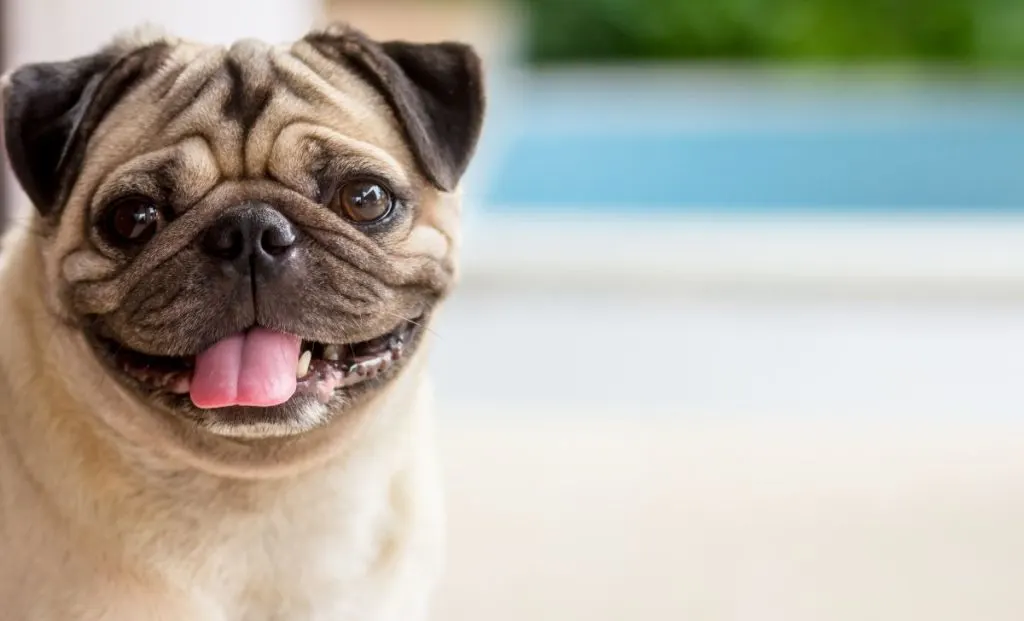
One of the most common questions prospective pet parents ask us is when will their loving dog reach a full size.
The truest answer would be: It depends. However, with all the things we know about dog development, we can make some predictions.
Pugs are small dogs, which means they develop faster than big dogs. Many Pugs will reach their full adult size by the time they are 10 months of age.
However, it can take up to 2 years for them to reach a full weight, considering how it takes some time for them to bulk up.
From then, the Pug’s weight should be stable until they reach senior years. Old dogs can lose some weight, so minor fluctuations are expected once your Pug is 8 – 10 years old.
Factors That Affect Growth
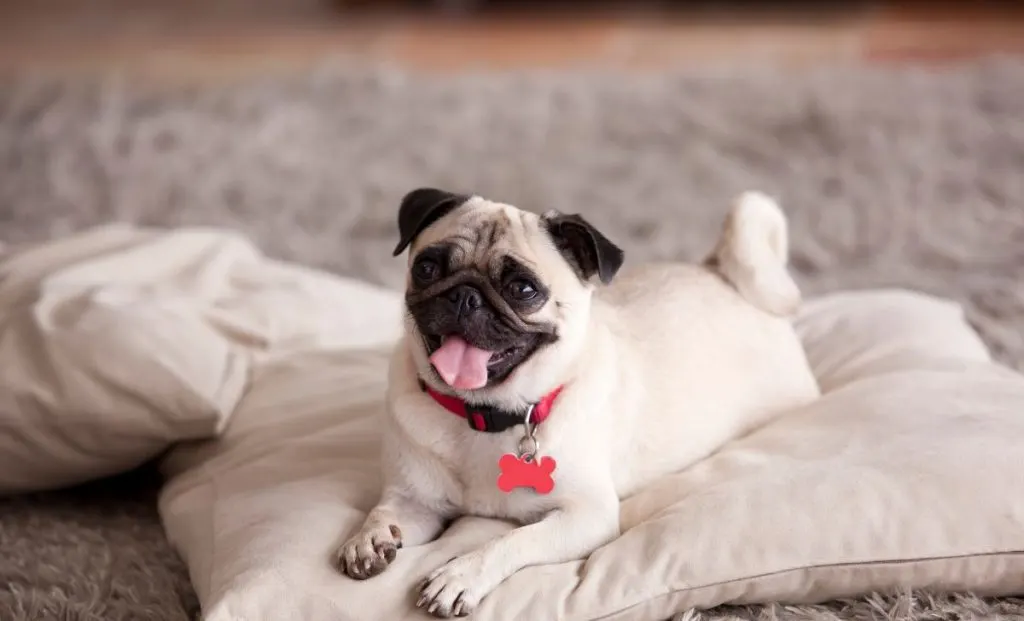
Pugs come in small sizes. You don’t expect them to grow big or that you’ll need to help them reach the healthiest weight possible.
However, many factors can affect the overall size of a Pug dog.
Sure, you don’t want your Pug to be too big, but you also don’t want him to stay too small. Both extremes can indicate something is terribly wrong with your pooch.
By providing your pup with the best care possible, you’ll also ensure he reaches the right size for his breed.
Here are some valuable information:
Nutrition
A nutritious diet is the key to your dog growing strong and tall – at least in a manner of speaking, considering how Pugs can never be really tall.
Your dog’s food intake will depend on his age. A feeding chart can greatly help you understand just how much food your pup needs.
Also, while dry kibble is always the safe and the most convenient option, many times it just doesn’t have enough nutrients such as wet canned food.
Your pup needs lots of protein, good fats, and carbs, no matter how small. The incorrect diet and malnutrition can lead to your dog being too small.
Also, it’s important to take food allergies into consideration. Pugs have sensitive stomachs, and they are prone to various allergies.
Make slow changes when tweaking your dog’s food. This is the best way to avoid stomach ache, diarrhea, and vomiting – all of which can negatively affect your Pug’s growth.
Exercise

Sure, Pugs are couch potatoes, but even they need some activity!
A small amount of daily exercise, such as short walks, is a perfect way to keep your doggie occupied.
A proper amount of activity is good for your dog’s bone development, and it can help prevent many health issues that can result in having a small dog.
Remember that Pugs, especially young puppies, shouldn’t be too active. Due to their flat faces, they are likely to suffer from brachycephalic syndrome, which can make it hard to breathe after an extensive exercise
Socialization and Training
Due to their calm nature, Pugs can trick you into thinking they don’t need much training and socialization. But the truth is, they do, and improper training can even affect their growth. How come?
If a puppy isn’t trained properly, he is more likely to eat something that he shouldn’t have and to become sick. Any illness gained in puppyhood can result in stunted growth.
I know mischief is a classic puppy feature. However, it can lead him into trouble, and, as a result, affect his further development.
Genetics
Genetics play a crucial factor in pretty much anything in the dog’s life, and this includes a Pug size.
Your Pug will inherit the genes that will determine his size from his parents. If his parents were pretty small – for example, if they were runts of the litter – your dog is likely to stay small.
Similarly, if your Pug had parents that were larger than the norm, he’d most likely grow to be fairly large himself.
Things can become tricky if recessive genes play a part, as they can stay hidden for generations. However, this is quite rare, especially if you’re buying from reputable breeders who choose their breeding stock carefully.
The best way to determine your Pug’s future full size is to look at his parents.
If this isn’t possible, don’t worry. Genetic testing can let you know many things about your dog, including its height. Contact your veterinarian to see whether they conduct these tests.
Health

Many health conditions can affect your dog’s health.
Most importantly, this includes parasites, such as tapeworms and ringworms. These terrible critters will live in your dog’s intestines, eating away the nutrients he had intake. This results in malnutrition and then in stunted growth.
Fortunately, most of these parasites are easy to get rid of, and your pup will start growing normally once he is treated.
However, if the parasites persist for too long, your Pug might remain smaller than expected.
Bone and joint disorders can also do more harm than you might think. A simple case of hip dysplasia, another common condition, can result in a dog that cannot grow properly.
Everything is only worsened with the brachycephalic syndrome these pups struggle with!
This is why regular vet visits are a must. By taking your dog to the professional every month in early puppyhood and then every year in adulthood, you can greatly increase his chances to not only grow to his full size but also to live the best life possible.
Environment
The environment can greatly affect Pug’s growth stages. While this will have the largest impact on his mental development, the physical one can also suffer.
Your dog needs a stable, loving home with lots of space for playtime.
On the other hand, stressful surroundings may lead to abnormal and even destructive behaviors, as well as stunt growth. As a result, you should always provide your pooch with a safe and happy environment.
Mental Stimulation
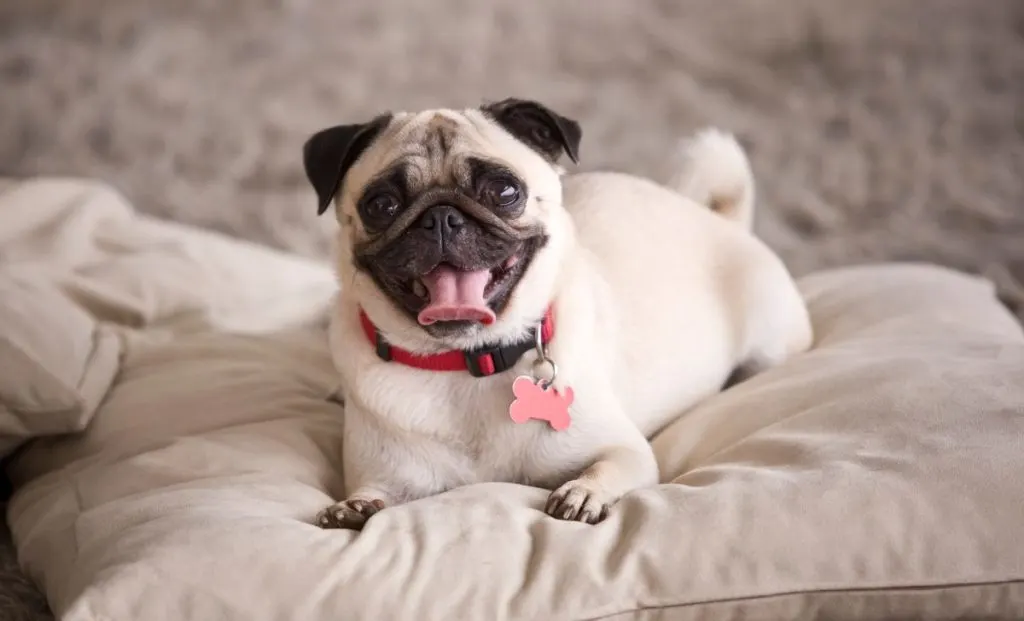
Mental stimulation is extremely important for every dog. Otherwise, you’ll be dealing with a bored and sad puppy that cannot develop properly.
Pugs are intelligent and sensitive doggies and they require lots of activities that will keep their mind occupied.
This includes puzzle toys, interactive games, as well as obedience training classes.
Sure, your pug might be a couch potato, but that doesn’t mean he cannot get bored. You need to do all you can to make sure he is having as much fun as possible.
Hormonal Changes
Pugs will go through puberty when they are between six months and a year and a half old. The hormonal changes that occur at this time can affect your Pug’s growth.
Your dog will go through a huge transformation at this age, both physically and mentally. While spaying and neutering are important, you should consult with your vet before conducting it so you don’t disrupt these natural processes.
While female Pugs are more prone to emotional rollercoasters, males will be more physically affected by the changes in their hormone levels.
For example, one piece of research has shown that fixing your dog too early can result in a larger size. This is because the sex hormones help speed up the closing of the growth plate.
As you can see, it’s essential to contact your vet about when is the right time to spay or neuter your dogs. If you do it at the wrong moment, you might affect your pup’s health.
Hydration
Proper hydration is extremely important for your dog’s growth and well-being.
Water is a crucial part of the digestion process, as it helps the body absorb nutrients. It also aids in the dog’s physical appearance, since it’ll keep the skin and coat looking freshly.
Pugs should always have fresh water available, especially on hot summer days when they might be hyperventilating and having breathing issues.
Dehydration can halt the dog’s growth and have a negative impact on his health. In the most severe cases, this can lead to severe problems and even death.
Sleep
All living beings need sleep – especially Pug puppies and senior dogs.
Make sure your Pug puppy has calm sleeping surrounds and allow him to have a quality sleep. This is necessary for muscle formation, as well as brain development.
Without adequate sleep, your Pug might not grow as big as he’s supposed to be.
Optimal Diet For Growth Support
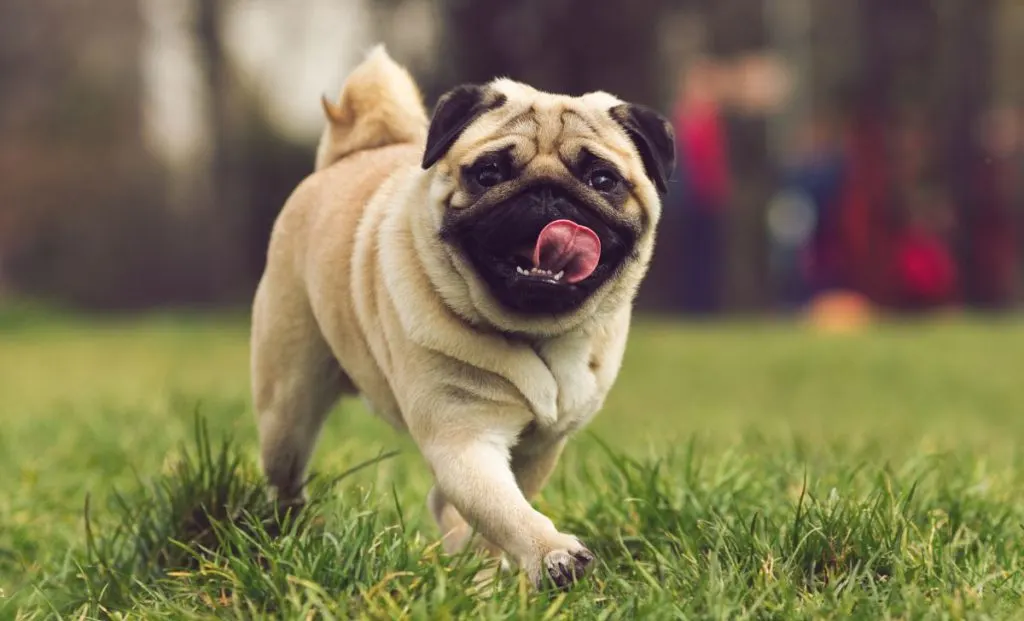
As mentioned above, a healthy diet is one of the most important decisions you should make regarding your new pup.
All dogs need a balanced diet of foods designed for its age, size, activity levels, and other factors.
For example, your little growing Pug will need a dry kibble or wet canned food designed for small breed puppies that aren’t very active.
Choosing the right type of food is essential not only for providing your dog with all the healthy nutrients his body needs to grow, but also to keep him from eating too many calories.
Pugs are prone to obesity, and an improper diet can result in them being overweight.
A Pug’s feeding chart can give you a good insight in feeding these tiny dogs.
A general rule of thumb is to feed your puppy small portions of puppy food four to three times a day until they are around six months old. Then, it’s time to slowly switch to adult food and to reduce the number of feedings to two.
When choosing the proper brand of food, make sure to check whether they are complying to the standards set out by the Association of American Feed Control Officials (AAFCO). This is the best way to ensure the food is healthy and checked by the experts.
Health Problems Associated With Growth

As I’ve briefly mentioned, there are several health conditions that are connected with Pug’s growth.
First and foremost, we have the brachycephalic syndrome which affects a dog’s breathing. If your pooch has any excess weight, this can worsen the symptoms of the syndrome, making his life much harder than it should be.
A few other health conditions include hip dysplasia, Patellar Luxation, as well as Legg-Calvé-Perthes Disease.
All of these health problems can delay your Pug’s growth or make him develop improperly. Not only that, but obesity can put a strain on the dog’s joints and bones, making these conditions much more severe.
The best preventive care measure is to take your pup to regular checkups with your local vet. A professional can help keep your dog healthy, and provide you with proper treatment the moment they notice something might be wrong.
Of course, it’s also important to feed your Pug properly and to provide him with about 30 minutes of easy walks every day. This will ensure his weight is within the limits checked by the Pug growth chart and reduce the chances of many illnesses.
Why Is My Pug So Big?
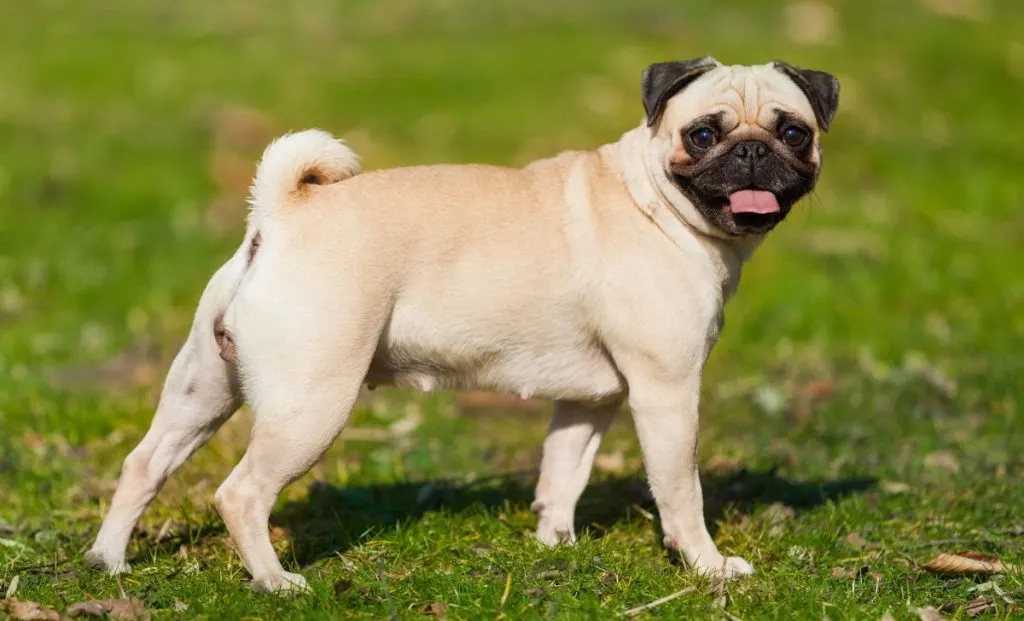
Pugs are known for their small size, so once you notice just how big your Pug is, maybe you’ll start asking yourself this common question.
First off, make sure to check the Pug growth chart. Maybe your Pug is in the right size for his age, but you simply never realized that they are not as tiny as some other breeds.
If your pup is too heavy, he might be struggling with canine obesity. Contact your local vet to see what type of diet is suitable to help your pup lose the excess weight.
Maybe you’ve spayed or neutered your dog too early, or his parents were quite big for the breed. These two factors can also greatly impact his final size.
Regardless, all Pugs are excellent dogs that will make your whole day much more fun. It is your duty to provide them with the best life possible – and one of the ways to do just that is to make sure they are of the proper weight.
Good luck in raising your adorable little doggie!
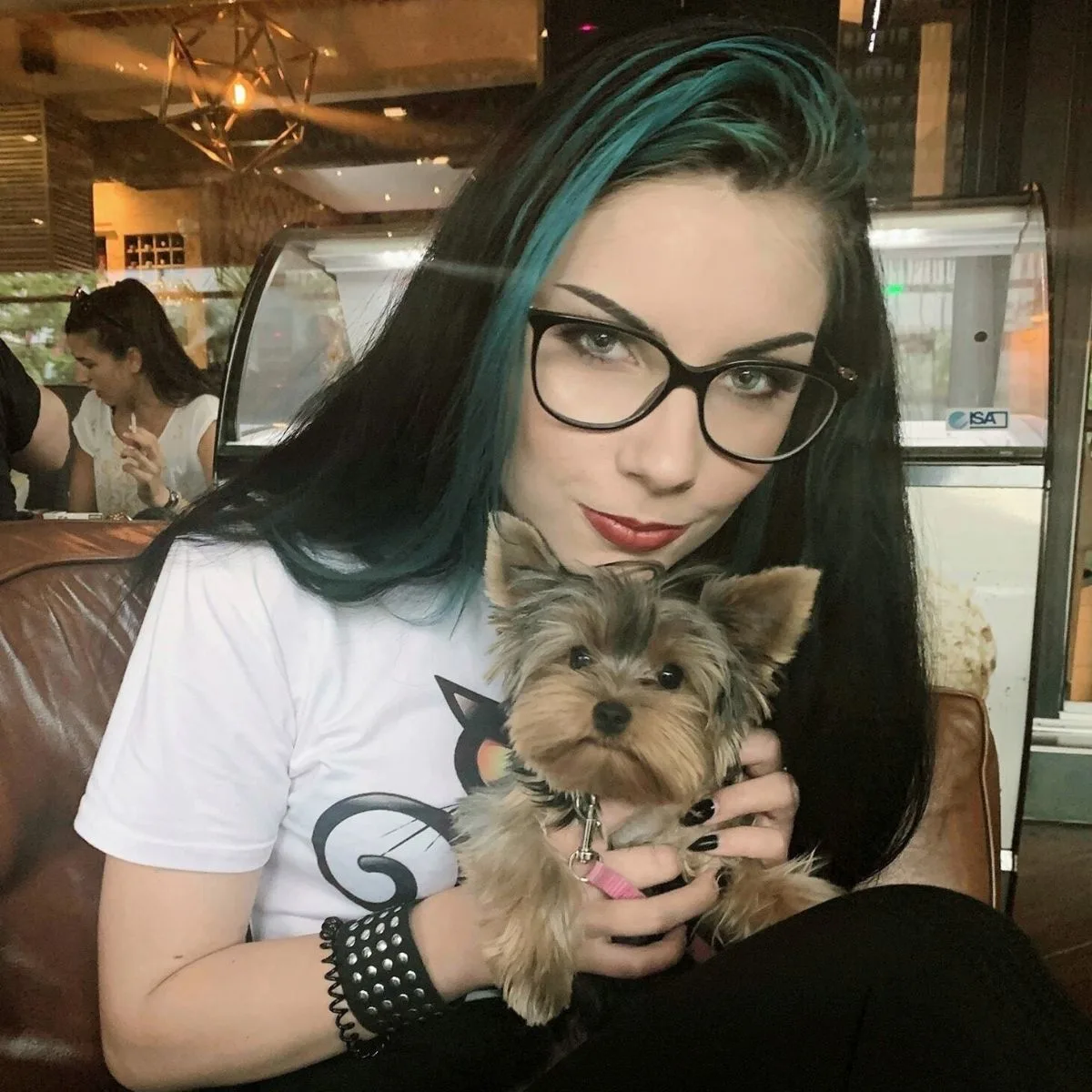
Vanja’s passion for writing started at an early age, which is why she pursued Journalism as her college degree. She can research any topic and find all the information before you bat an eye, which is a great thing for her job but a terrible one for her husband.
Even as a young child, she fell in love with everything fluffy – but dogs have a special place in her heart due to her childhood companion, a Corgie named Archie.
Motivated by her experiences and driven by a desire to give back to her four-legged companions, she spends her free time volunteering at a local dog shelter.
